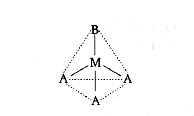A complex with the composition [MA3B]n± is found to have no geometrical isomers. The possible structure (s) of the complex is (where A and B are monodentate ligands)
tetrahedral
Square planar
Both (a) and (b)
cannot be predicted
The correct Answer is:C

⇒In this square planar complex, only one configuration is possible. Hence, geometrical isomerism is not observed.

⇒Tetrahedral complexes never show geometrical isomerism.
Topper's Solved these Questions
- BOOK - VK JAISWAL ENGLISHCHAPTER - CO-ORDINATION COMPOUNDSEXERCISE - LEVEL 3 (PASSAGE TYPE)98videos
CO-ORDINATION COMPOUNDS
- BOOK - VK JAISWAL ENGLISHCHAPTER - CO-ORDINATION COMPOUNDSEXERCISE - ONE OR MORE ANSWERS IS/ARE CORRECT71videos
CO-ORDINATION COMPOUNDS
- BOOK - VK JAISWAL ENGLISHCHAPTER - CHEMICAL BONDING (BASIC)EXERCISE - SUBJECTIVE PROBLEMS54videos
CHEMICAL BONDING (BASIC)
- BOOK - VK JAISWAL ENGLISHCHAPTER - d-BLOCK ELEMENTSEXERCISE - ASSERTION-REASON TYPE QUESTIONS32videos
d-BLOCK ELEMENTS
Similar Questions
How many geometrical isomers are possible for MA2B2C2 ?
View SolutionHow many geometrical isomers are possible for complex [Mab(AB)2]n±?
View SolutionThe complex, [Pt(py)(NH3)BrCl] will have how many geometrical isomers?
View SolutionWhich of the following octahedral complex does not show geometrical isomerism (A and B are monodentate ligands) ?
View SolutionWhich of the following octahedral complex does not show geometrical isomerism (A and B are monodentate ligands) ?
View SolutionCis-trans isomerism is found in square planar complexes of molecular formula: (a and b are monodentate ligands)
View SolutionThe number of possible sterio isomers in Ma3b3 is equal to
(Here a, b are different monodentate ligands).View SolutionThe possible geometric isomers of the complex , [Co(en)Br2Cl2]− is :
View SolutionHow many isomers are possible for the complex [Ir(CO)Cl(PPh3)2]?
View SolutionThe total No. of isomers possible for the complex [Co(en)2Cl2] is :-
View Solution

